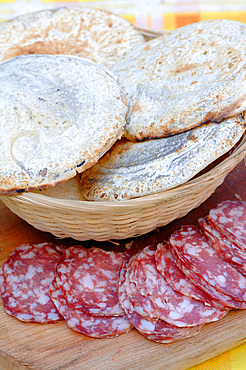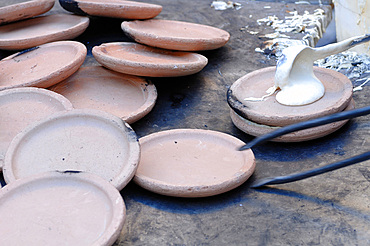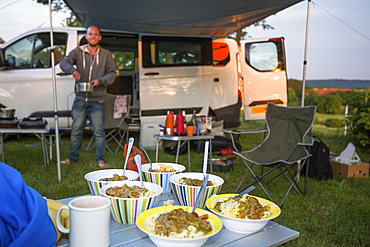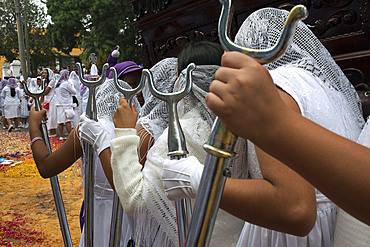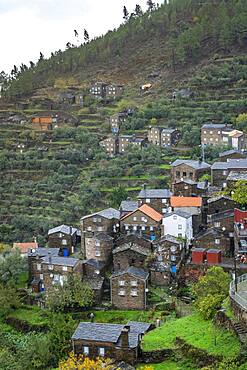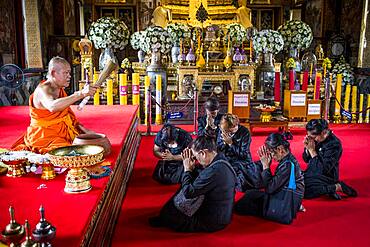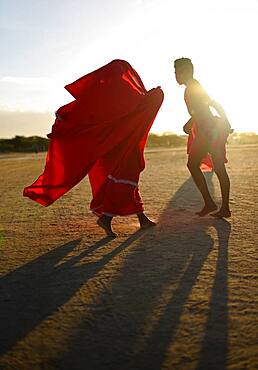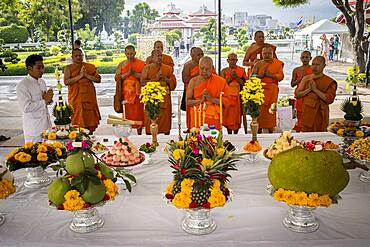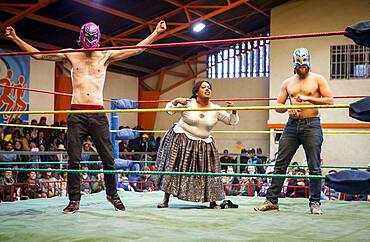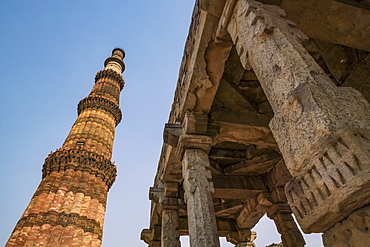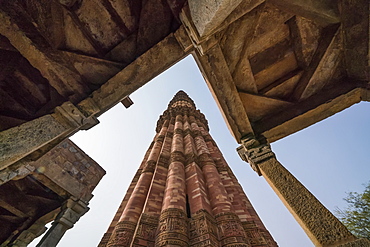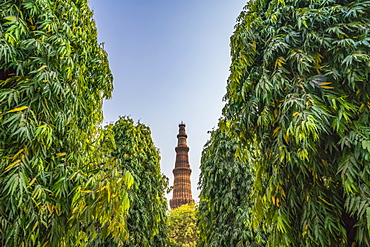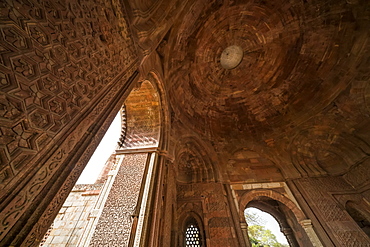Recent searches
Loading...
746-90189 - Cerere statue, the Sacro Bosco, Sacred Grove colloquially called Park of the Monsters, XVI century, Parco dei Mostri in Italian, Bomarzo, Lazio, Italy, Europe
746-90527 - Potato cake, a typical dish of the so-called white cuisine of the hinterland of western Liguria; Mendatica; Imperia; Liguria, Italy
746-90615 - Panigaccio is a type of round, unleavened bread, baked in a special terracotta and mica dish, called testo, red-heated over high heat in a bonfire or in a wood-burning oven. A batter of flour, water and salt is interposed between one text and another, to form a pile. It is typical of the Lunigiana land on the border between Liguria and Tuscany, Italy, Europe
746-90528 - Turle (potato and mint ravioli seasoned with milk cream, garlic or leek) and stuffed onions, typical dishes of the so-called white cuisine of the hinterland of western Liguria; Mendatica; Imperia; Liguria, Italy
746-90190 - Ogre, the Sacro Bosco, Sacred Grove colloquially called Park of the Monsters, XVI century, Parco dei Mostri in Italian, Bomarzo, Lazio, Italy, Europe
1350-5144 - There are twenty three main platform, with the end of the procession marked by that dedicated to Our Lady of Solitude also called ,??La Dolorosa,?? because of the expression her face takes on upon seeing her dead Son, The statue is carried by around 40 men, carrying upon their shoulders a weight of over a ton,
746-90186 - Venere, the Sacro Bosco, Sacred Grove colloquially called Park of the Monsters, XVI century, Parco dei Mostri in Italian, Bomarzo, Lazio, Italy, Europe
746-90194 - Furia, the Sacro Bosco, Sacred Grove colloquially called Park of the Monsters, XVI century, Parco dei Mostri in Italian, Bomarzo, Lazio, Italy, Europe
746-90614 - Panigaccio is a type of round, unleavened bread, baked in a special terracotta and mica dish, called testo, red-heated over high heat in a bonfire or in a wood-burning oven. A batter of flour, water and salt is interposed between one text and another, to form a pile. It is typical of the Lunigiana land on the border between Liguria and Tuscany, Italy, Europe
746-90188 - Neptune, the Sacro Bosco, Sacred Grove colloquially called Park of the Monsters, XVI century, Parco dei Mostri in Italian, Bomarzo, Lazio, Italy, Europe
746-90052 - The birth is due to the Bourbon king Ferdinand III of Sicily who had a hunting lodge built here in 1799, called Real Casina di Caccia, after having bought the Cappelliere fiefs, Corleone, Sicily, Italy, Europe
746-90193 - Echidna, the Sacro Bosco, Sacred Grove colloquially called Park of the Monsters, XVI century, Parco dei Mostri in Italian, Bomarzo, Lazio, Italy, Europe
746-90526 - Potato cake, a typical dish of the so-called white cuisine of the hinterland of western Liguria; Mendatica; Imperia; Liguria, Italy
746-90612 - Panigaccio is a type of round, unleavened bread, baked in a special terracotta and mica dish, called testo, red-heated over high heat in a bonfire or in a wood-burning oven. A batter of flour, water and salt is interposed between one text and another, to form a pile. It is typical of the Lunigiana land on the border between Liguria and Tuscany, Italy, Europe
1350-5099 - The participants, called ,??costaleros,??, have their head covered by a long, pointed hood adding drama to the action,
1350-5264 - There are twenty three main platform, with the end of the procession marked by that dedicated to Our Lady of Solitude also called ,??La Dolorosa,?? because of the expression her face takes on upon seeing her dead Son, The statue is carried by around 40 men, carrying upon their shoulders a weight of over a ton,
832-394722 - Amazing colors of sea salt ponds called salines shortly before salt extraction in Portugal
832-394723 - Amazing colors of sea salt ponds called salines shortly before salt extraction in Portugal
832-394755 - Faerberturm also called Pulverturm, Gunzenhausen, Altmuehltal, Franconian Lake District, Franconia, Bavaria, Germany, Europe
832-394724 - Amazing colors of sea salt ponds called salines shortly before salt extraction in Portugal
832-393882 - Wooden roof called Setas de Sevilla and amazing panoramic view of the city, Seville, Andalusia, Spain, Europe
1348-3095 - Color satellite image of Mumbai and Navi Mumbai, India. Navi Mumbai is a planned township located East of Mumbai. Both cities are connected by the Vashi bridge, also called Thane Creek Bridge
1116-52140 - A stop for the night at a Czech Republic campsite between Prague and Cesky Krumlov. The 50 person town is called Kostelec and it is on the outsirts of Hluboka nad Vltavou. A camper prepares dinner for his friends; Kostelec, Vltavou, Czech Republic
1116-52141 - A stop for the night at a Czech Republic campsite between Prague and Cesky Krumlov. The 50 person town is called Kostelec and it is on the outsirts of Hluboka nad Vltavou. A camper sets up dinner at their campsite; Kostelec, Vltavou, Czech Republic
832-393351 - Chamois (Rupicapra rupicapra) and mountain landscape above clouds at Rosskofel, called Monte Cavallo di Pontebba, is located in the west of the ski area Nassfeld and is a karst mountain, Austria, Europe
832-393295 - Traditional Portuguese tiles called azulejos on one of the old houses in Faro, Portugal, Europe
832-393286 - Old town or so called Medina of Agadir, Morocco, Africa
1112-6128 - The cone geyser called Old Faithful erupting, Yellowstone National Park, UNESCO World Heritage Site, Wyoming, United States of America, North America
1112-6127 - The cone geyser called Old Faithful erupting, Yellowstone National Park, UNESCO World Heritage Site, Wyoming, United States of America, North America
1112-6129 - The cone geyser called Old Faithful erupting, Yellowstone National Park, UNESCO World Heritage Site, Wyoming, United States of America, North America
1350-3751 - Holy Week processions in Guatemala city. Holy Thursday. Holy Week in Guatemala is celebrated with street expressions of faith, called processions, usually organized by a "hermandades". Each procession of Holy Week has processional floats and steps, which are often religious images of the Passion of Christ, or Marian images, although there are exceptions, like the allegorical steps of saints.
1350-3753 - Holy Week processions in Guatemala city. Holy Thursday. Comparsa. Holy Week in Guatemala is celebrated with street expressions of faith, called processions, usually organized by a "hermandades". Each procession of Holy Week has processional floats and steps, which are often religious images of the Passion of Christ, or Marian images, although there are exceptions, like the allegorical steps of saints.
832-392143 - Amazing old village with schist houses, called Piodao in Serra da Estrela, Portugal, Europe
832-393028 - Plenty of tasty sandwiches with Spanish ham called jamon
832-392141 - Amazing old village with schist houses, called Piodao in Serra da Estrela, Portugal, Europe
832-392905 - Aerial view of the rock above Oberailsfeld with cyclist figure, called Claudius, Oberailsfeld, Franconian church village, district of Ahorntal, Ailsbachtal, Franconian, Franconian Alb, Upper Franconia, Franconia, Bavaria, Germany, Europe
832-392142 - Amazing old village with schist houses, called Piodao in Serra da Estrela, Portugal, Europe
1311-356 - A hoodoo formation called Medusa's Child, below the cliffs of Agate Plateau in Petrified Forest National Park, Arizona, United States of America, North America
1311-357 - A hoodoo formation called Medusa's Child below the cliffs of Agate Plateau in Petrified Forest National Park, Arizona, United States of America, North America
1311-355 - A long formation of purple Bentonite clay called the Purple Peninsula, in Petrified Forest National Park, Arizona, United States of America, North America
1350-1865 - Yonna dance, also called Chichamaya, carries a considerable symbolic charge for the Wayuu indigenous people of Colombia, representing three basic principles for this tribal group: Social equality, collective solidarity and the improvement of relations between the human being and the Cosmos.
1350-1859 - Yonna dance, also called Chichamaya, carries a considerable symbolic charge for the Wayuu indigenous people of Colombia, representing three basic principles for this tribal group: Social equality, collective solidarity and the improvement of relations between the human being and the Cosmos.
1350-1871 - Yonna dance, also called Chichamaya, carries a considerable symbolic charge for the Wayuu indigenous people of Colombia, representing three basic principles for this tribal group: Social equality, collective solidarity and the improvement of relations between the human being and the Cosmos.
1350-1450 - Monk blessing women, in Wat Arun (Temple of Dawn), also called Wat Bangmakok Noek, Bangkok, Thailand
1350-114 - Comet NEOWISE (C/2020 F3) over the still waters this night of Crawling Lake in southern Alberta. This was early in the evening with the sky still brightly coloured with twilight. The comet was in the southern part of Ursa Major between the pairs of stars called Tania and Talitha. The clouds that were present nicely framed the scene and reflected in the water as well. The comet was too high to be visible as a reflection at this time.
1350-1860 - Yonna dance, also called Chichamaya, carries a considerable symbolic charge for the Wayuu indigenous people of Colombia, representing three basic principles for this tribal group: Social equality, collective solidarity and the improvement of relations between the human being and the Cosmos.
1350-1861 - Yonna dance, also called Chichamaya, carries a considerable symbolic charge for the Wayuu indigenous people of Colombia, representing three basic principles for this tribal group: Social equality, collective solidarity and the improvement of relations between the human being and the Cosmos.
1350-1862 - Yonna dance, also called Chichamaya, carries a considerable symbolic charge for the Wayuu indigenous people of Colombia, representing three basic principles for this tribal group: Social equality, collective solidarity and the improvement of relations between the human being and the Cosmos.
1350-1866 - Yonna dance, also called Chichamaya, carries a considerable symbolic charge for the Wayuu indigenous people of Colombia, representing three basic principles for this tribal group: Social equality, collective solidarity and the improvement of relations between the human being and the Cosmos.
1350-1870 - Yonna dance, also called Chichamaya, carries a considerable symbolic charge for the Wayuu indigenous people of Colombia, representing three basic principles for this tribal group: Social equality, collective solidarity and the improvement of relations between the human being and the Cosmos.
1350-1868 - Yonna dance, also called Chichamaya, carries a considerable symbolic charge for the Wayuu indigenous people of Colombia, representing three basic principles for this tribal group: Social equality, collective solidarity and the improvement of relations between the human being and the Cosmos.
1350-1858 - Yonna dance, also called Chichamaya, carries a considerable symbolic charge for the Wayuu indigenous people of Colombia, representing three basic principles for this tribal group: Social equality, collective solidarity and the improvement of relations between the human being and the Cosmos.
1350-1451 - Monks, religious ceremony, in Wat Arun (Temple of Dawn), also called Wat Bangmakok Noek, Bangkok, Thailand
1350-645 - Episyrphus balteatus, sometimes called the marmalade hoverfly; like most other hoverflies it mimics a much more dangerous insect, the solitary wasp, though it is a quite harmless species
1350-1869 - Yonna dance, also called Chichamaya, carries a considerable symbolic charge for the Wayuu indigenous people of Colombia, representing three basic principles for this tribal group: Social equality, collective solidarity and the improvement of relations between the human being and the Cosmos.
1350-678 - The sponging mouthparts consist of a fleshy, elbowed labium, at the distal end of which are large, sponge-like organs called the labella (singular, labellum). The labella is a complex structure consisting of many grooves, called pseudotrachea, which sops up liquids much like a sponge does.
1350-831 - Lucha Libre.Two spontaneous up to the ring to help the cholita Angela la Folclorista during the combat again the wrestler called El Prisionero, Sports center La Ceja, El Alto, La Paz, Bolivia
1350-1863 - Yonna dance, also called Chichamaya, carries a considerable symbolic charge for the Wayuu indigenous people of Colombia, representing three basic principles for this tribal group: Social equality, collective solidarity and the improvement of relations between the human being and the Cosmos.
1350-1864 - Yonna dance, also called Chichamaya, carries a considerable symbolic charge for the Wayuu indigenous people of Colombia, representing three basic principles for this tribal group: Social equality, collective solidarity and the improvement of relations between the human being and the Cosmos.
1350-1867 - Yonna dance, also called Chichamaya, carries a considerable symbolic charge for the Wayuu indigenous people of Colombia, representing three basic principles for this tribal group: Social equality, collective solidarity and the improvement of relations between the human being and the Cosmos.
860-289119 - Radish 'Noir long maraicher' : 'Black long market gardener'. Winter radish also called 'Noir long poids d'horloge : 'Black long clock weight'
860-289021 - GR 120 from Sangatte, also called Sentier du Littoral, it stretches along the Opal Coast, from the Belgian border to Berck-sur-Mer, Hauts de France, France
1311-350 - A Bentonite formation in Petrified Forest National Park near Crystal Forest called the Battleship, Arizona, United States of America, North America
1311-349 - Natural stone bridge of petrified wood called Keystone Bridge, located on Blue Mesa in Petrified Forest National Park, Arizona, United States of America, North America
1311-345 - An eroded sandstone formation called a Sandcastle, below the Blue Mesa in Petrified Forest National Park, Arizona, United States of America, North America
1311-340 - A rock formation called Agate Mesa, Petrified Forest National Park, Arizona, United States of America, North America
1311-341 - Formation called Agate Mesa, viewed from a group of petrified wood in the foreground, Petrified Forest National Park, Arizona, United States of America, North America
1345-87 - Local Cachacaria where local drink called Chachaza is sold, Paraty, Rio de Janeiro State, Brazil
1116-49224 - The historic sight called Qutub Minar, Delhi, India
1116-49222 - The historic sight called Qutub Minar, Delhi, India
1116-49223 - The historic sight called Qutub Minar, Delhi, India
1116-49226 - The historic sight called Qutub Minar, Delhi, India
1116-49206 - The historic sight called Qutub Minar, Delhi, India
1116-49207 - The historic sight called Qutub Minar, Delhi, India
1116-49221 - The historic sight called Qutub Minar, Delhi, India
1116-49225 - The historic sight called Qutub Minar, Delhi, India
832-391230 - Chess flower, also called checkerboard flower (Fritillaria meleagris) in a wet meadow, sunset, Doubs nature park Park, Les Brenets, Canton Neuchatel, Switzerland, Europe
832-390145 - Famous Vietnamese soup called pho on wooden background
832-390059 - Moorish architecture of beautiful castle called Real Alcazar in Seville, Andalusia, Spain, Europe
1311-309 - The Bow Rock of the formation called Sinking Ship in Grand Canyon National Park, UNESCO World Heritage Site, Arizona, United States of America, North America
1311-306 - The Bow Rock of the formation called Sinking Ship in Grand Canyon National Park, UNESCO World Heritage Site, Arizona, United States of America, North America
1311-308 - Grandview Point viewed from the port bow of the formation called Sinking Ship, Grand Canyon National Park, UNESCO World Heritage Site, Arizona, United States of America, North America
1311-311 - View from the Starboard side of the formation called Sinking Ship in Grand Canyon National Park, UNESCO World Heritage Site, Arizona, United States of America, North America
1269-714 - Traditional Swiss village called Santa Maria in Val Mustair, Canton Graubunden, Switzerland, Europe
1113-104937 - Grazing pigs wallowing in the mud on a pasture. The breed is called Swabian-Hall Swine. Germering, Bavaria, Germany
1113-104936 - Grazing pigs wallowing in the mud on a pasture. The breed is called Swabian-Hall Swine. Germering, Bavaria, Germany
1113-104940 - Grazing pigs wallowing in the mud on a pasture. The breed is called Swabian-Hall Swine. Germering, Bavaria, Germany
1113-104942 - Grazing pigs wallowing in the mud on a pasture. The breed is called Swabian-Hall Swine. Germering, Bavaria, Germany
1113-104941 - Grazing pigs wallowing in the mud on a pasture. The breed is called Swabian-Hall Swine. Germering, Bavaria, Germany
1113-104938 - Grazing pigs wallowing in the mud on a pasture. The breed is called Swabian-Hall Swine. Germering, Bavaria, Germany
1113-104939 - Grazing pigs wallowing in the mud on a pasture. The breed is called Swabian-Hall Swine. Germering, Bavaria, Germany
1311-295 - A section of Petrified Forest National Park called Angel Garden, northwest of the Onyx Bridge, Arizona, United States of America, North America
1311-296 - The landmark in Petrified Forest National Park called Squared Off Butte, a marker on the way to Onyx Bridge, Arizona, United States of America, North America
832-389902 - Grained piece of beef, a so-called entrecote, lies on a fir branch decorated on a blue-black shimmering iron plate
809-8160 - Earth tower house, called takienta, of Batammariba people in Koutammakou region, La Kara, Togo, West Africa, Africa
809-8158 - Earth tower house, called takienta, of Batammariba people in Koutammakou region, La Kara, Togo, West Africa, Africa
809-8159 - Earth tower house, called takienta, of Batammariba people in Koutammakou region, La Kara, Togo, West Africa, Africa
832-388585 - An evening view of the buildings of the old town called Sassi, panoramic view, Matera, Italy, Europe
1112-5165 - King penguin (Aptenodytes patagonicus) chicks called Okum Boys at Gold Harbor, South Georgia, Polar Regions
1112-5166 - King penguin (Aptenodytes patagonicus) chicks called Okum Boys at Gold Harbor, South Georgia, Polar Regions


